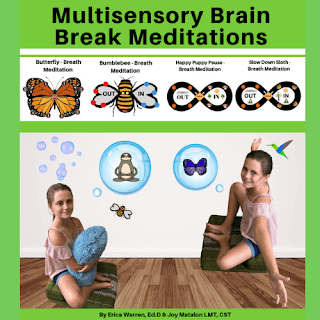This week I wanted to tell you about my online store, Good Sensory Learning. I’m Dr. Erica Warren, and I established this site so I could share all the materials that I have created over the last 20+ years as a learning specialist and educational therapist. When I first began my private practice, Learning to Learn, I had great difficulty finding fun and multisensory materials for my students that were effective and engaging. So back in 2005, I made it my mission to design and distribute high-end, remedial products as well as memorable, motivating lessons that bring delight to learning. If you would like to try a free sampling of my activities , CLICK HERE . How Are the Products Organized at Good Sensory Learning? You can download my Free Printable Catalog or you can browse the site using the grey “search all products” bar in the top right of any page with keywords such as dyslexia, working memory, and executive functioning. What’s more, drop down menus in the red banner allow you t...
With increasing academic expectations, the pressure on teachers to bring up test scores, and competitive classroom environments, more and more students are struggling with chronic stress and anxiety. So, what can we do to calm students and get their brains in a state for optimal learning?
First We Must Understand that Excessive Stress Negatively Impacts LearningWhile some nervousness can enhance memory, chronic stress and anxiety are emotions that have no place in a classroom. When excessive stress is experienced, the body makes too much cortisol, a steroid hormone that the body produces to assist you in responding to stress or danger, and this can disrupt cognitive functioning. Studies reveal that chronic stress can disrupt synapse regulation. This can result in reduced sociability and social isolation. In addition, high levels of cortisol can kill brain cells and even shrink the prefrontal cortex, the part of the brain that manages memory and learning.
Second, We Need to Provide Strategies to Calm Students' Bodies and Brains
Fortunately, there are numerous research-based methods that can help.
- Mindfulness
- Meditation
- Metacognition
- Breathing exercises
Did you know that students often think with half the brain, while the other half remains "offline?" When this happens, learning becomes practically impossible. However, when the left and right hemispheres are both activated and communicating, the brain is integrated. For academic activities, hemisphere integration is essential, because it allows students to fully process and comprehend lessons. So how can we awaken the whole brain?
Brain breaks can be a fun tool to engage and prime your students for learning. Brain Breaks are short, bursts of activity, and when they also implement certain movements, both hemispheres of the brain can be activated.
Are There Any Ready-Made Materials?
Multisensory Brain Break Meditations unite all of these strategies and can be used in a classroom or at home. They are great for preschool, kindergarten, and elementary students from grades 1-5. Click Here to learn more.
What about Helping Older Students?
I also offer Mindfulness Activity Cards that were created for older students. Based on the mindfulness, emotional intelligence, and social-emotional learning research, these publications can be implemented in classrooms or therapy sessions to develop emotional intelligence, resilience, and working memory. Furthermore, they can teach authentic dialogue and develop self-esteem. They are great for round table discussions, circle groups, and individual sessions.
What about Helping Older Students?
I also offer Mindfulness Activity Cards that were created for older students. Based on the mindfulness, emotional intelligence, and social-emotional learning research, these publications can be implemented in classrooms or therapy sessions to develop emotional intelligence, resilience, and working memory. Furthermore, they can teach authentic dialogue and develop self-esteem. They are great for round table discussions, circle groups, and individual sessions.
I hope you found this blog on calming meditations helpful. Teaching students to manage their stress and providing grounding resources in their environment can help to nurture resilient, resourceful, and confident learners.
Cheers, Dr. Erica Warren
Dr. Erica Warren is the author, illustrator, and publisher of multisensory educational materials at Good Sensory Learning and Dyslexia Materials. She is also the director of Learning to Learn and Learning Specialist Courses.
· Blog: https://learningspecialistmaterials.blogspot.com/
· YouTube Channel: https://www.youtube.com/user/warrenerica1
· Podcast: https://godyslexia.com/
· Store: http://www.Goodsensorylearning.com/ & www.dyslexiamaterials.com
· Courses: http://www.learningspecialistcourses.com/
· Newsletter Sign-up: https://app.convertkit.com/landing_pages/69400
Dr. Erica Warren is the author, illustrator, and publisher of multisensory educational materials at Good Sensory Learning and Dyslexia Materials. She is also the director of Learning to Learn and Learning Specialist Courses.
· Blog: https://learningspecialistmaterials.blogspot.com/
· YouTube Channel: https://www.youtube.com/user/warrenerica1
· Podcast: https://godyslexia.com/
· Store: http://www.Goodsensorylearning.com/ & www.dyslexiamaterials.com
· Courses: http://www.learningspecialistcourses.com/
· Newsletter Sign-up: https://app.convertkit.com/landing_pages/69400



Comments
Post a Comment